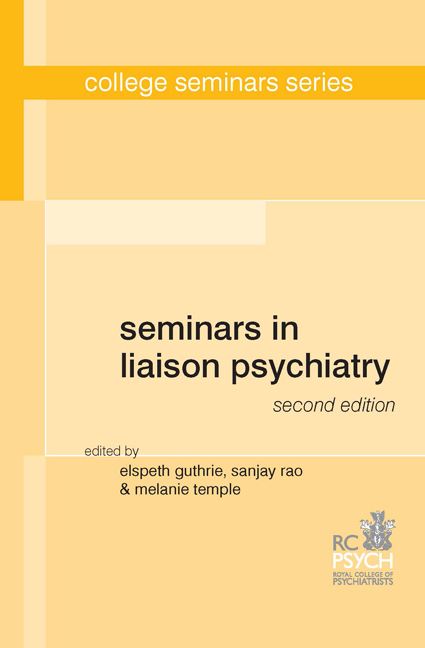Book contents
- Frontmatter
- Contents
- Abbreviations
- List of boxes, tables and figures
- List of contributors
- 1 Basic skills and competencies in liaison psychiatry
- 2 The liaison psychiatry curriculum
- 3 Classification and diagnosis
- 4 Capacity and consent
- 5 Psychological reaction to physical illness
- 6 Medically unexplained symptoms
- 7 Alcohol and substance use in the general hospital
- 8 Accident and emergency psychiatry and self-harm
- 9 Perinatal psychiatry
- 10 General medicine and its specialties
- 11 Liaison psychiatry and surgery
- 12 Neuropsychiatry for liaison psychiatrists
- 13 Psycho-oncology
- 14 Palliative care psychiatry
- 15 Sleep disorders
- 16 Weight- and eating-related issues in liaison psychiatry
- 17 Disaster management
- 18 Liaison psychiatry and older people
- 19 Paediatric liaison psychiatry
- 20 Primary care and management of long-term conditions
- 21 Occupational medicine
- 22 HIV and liaison psychiatry
- 23 Sexual dysfunction
- 24 Psychopharmacology in the medically ill
- 25 Psychological treatments in liaison psychiatry
- 26 Research, audit and rating scales
- 27 Service models
- 28 Developing liaison psychiatry services
- 29 Multiple choice questions and extended matching items
- Appendix 1 Specific competencies
- Appendix 2 Learning objectives with assessment guidance
- Index
8 - Accident and emergency psychiatry and self-harm
- Frontmatter
- Contents
- Abbreviations
- List of boxes, tables and figures
- List of contributors
- 1 Basic skills and competencies in liaison psychiatry
- 2 The liaison psychiatry curriculum
- 3 Classification and diagnosis
- 4 Capacity and consent
- 5 Psychological reaction to physical illness
- 6 Medically unexplained symptoms
- 7 Alcohol and substance use in the general hospital
- 8 Accident and emergency psychiatry and self-harm
- 9 Perinatal psychiatry
- 10 General medicine and its specialties
- 11 Liaison psychiatry and surgery
- 12 Neuropsychiatry for liaison psychiatrists
- 13 Psycho-oncology
- 14 Palliative care psychiatry
- 15 Sleep disorders
- 16 Weight- and eating-related issues in liaison psychiatry
- 17 Disaster management
- 18 Liaison psychiatry and older people
- 19 Paediatric liaison psychiatry
- 20 Primary care and management of long-term conditions
- 21 Occupational medicine
- 22 HIV and liaison psychiatry
- 23 Sexual dysfunction
- 24 Psychopharmacology in the medically ill
- 25 Psychological treatments in liaison psychiatry
- 26 Research, audit and rating scales
- 27 Service models
- 28 Developing liaison psychiatry services
- 29 Multiple choice questions and extended matching items
- Appendix 1 Specific competencies
- Appendix 2 Learning objectives with assessment guidance
- Index
Summary
The accident and emergency (A&E) department is one of the most accessible elements of health services. Individuals can walk in and request help. It is normally the first port of call for ambulances. Towns and cities have road signs giving directions to the local A&E. Despite the recent drive in the UK to develop alternatives to A&E such as polyclinics and urgent care centres, A&E remains, for many people, the epitome of urgent healthcare. People attend in large numbers and a significant proportion of these will have mental health problems. The first experience of mental health services for many people is the assessment they receive while attending A&E. The importance of first impressions cannot be overstated, particularly as significant numbers of such patients will require ongoing care from mental health services.
The A&E environment can pose challenges to the clinician when conducting a thorough assessment. There may be pressures to conduct an assessment in conditions of disturbance or lack of privacy, or for the assessment to be rushed. It is incumbent on the clinician to ensure that a thorough assessment is conducted in as appropriate an environment as possible.
As A&E allows direct access to the public, the full range of psychiatric conditions can present in this setting. Those which merit special attention, as they are more frequently seen, are discussed in this chapter.
Self-harm
Self-harm imposes a major burden on health services and is a common reason for presentation to A&E (accounting for as many as 200 000 hospital attendances per year in the UK; Hawton et al, 2007). Assessment of individuals who have self-harmed may make up a significant proportion of the workload of liaison psychiatry departments. Patients who self-harm are at increased risk of subsequent suicide, and up to half of those who die by suicide have a history of self-harm. Effective management of self-harm may contribute to suicide prevention.
Terminology
Various terms have been used to describe non-fatal suicidal behaviour (e.g. parasuicide, attempted suicide, overdose, self-injurious behaviour) and none is entirely satisfactory. ‘Deliberate self-harm’ can be defined as an act of intentional self-poisoning or injury irrespective of the apparent purpose of the act (NHS Centre for Reviews and Dissemination, 1998).
- Type
- Chapter
- Information
- Seminars in Liaison Psychiatry , pp. 101 - 117Publisher: Royal College of PsychiatristsFirst published in: 2017



